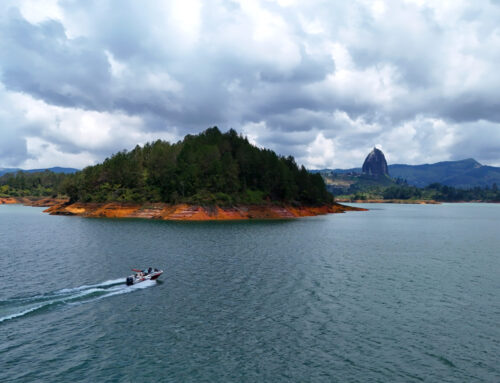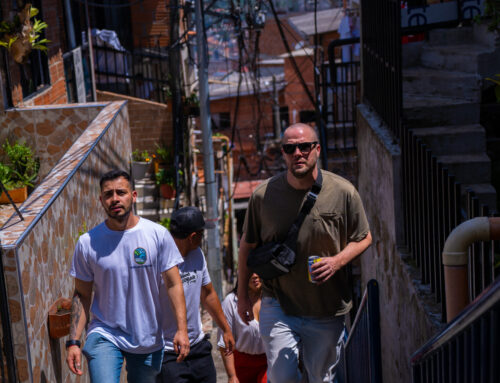Standing tall against the Colombian sky, the Rock of Guatape is more than just a geological marvel. It’s a place steeped in history, a silent witness to the triumphs and struggles of a community. Its story is woven with threads of ancient reverence, the relentless march of progress, and the ever-evolving relationship between humanity and the natural world.
For millennia, the Rock stood as a silent observer, a weathered monolith towering over the verdant valleys. The indigenous Tahamí people considered it sacred, a place of deep spiritual connection they called “mojarrá,” meaning “rock” or “stone.” Gazing upon its weathered face, you can almost feel a connection to the enduring power of the natural world.
The 20th century, however, brought a period of dramatic change. The allure of progress arrived in the form of a hydroelectric dam project, promising to power a growing nation. But progress often comes at a cost. The rising waters of the Peñol-Guatape reservoir swallowed the town of El Peñol whole, forcing its residents to abandon their homes and ancestral lands.
The displacement was a deeply personal loss. Memories of life on the banks of the Negro-Nare River, the sound of flowing water, and the familiar routines of a close-knit community were now submerged beneath the artificial lake. A new El Peñol was built nearby, facing away from the reservoir, a constant reminder of what was lost.
The Rock, however, remained defiant. Standing resolute above the waterline, it became a point of playful contention between El Peñol and the neighboring town of Guatape. In a mischievous display of local pride, Guatape residents attempted to settle the matter by painting their town’s name on the Rock’s face in giant white letters. Though the project was never finished, the inscription stands as a testament to the good-natured rivalry between the two communities.
Today, the Rock of Guatape is a major tourist attraction. Thousands of visitors make the climb up the 740 steps, each step a testament to human ingenuity and the reward of a breathtaking panoramic vista. At the summit, a vibrant scene unfolds – a viewing platform offering stunning views of the Peñol-Guatape reservoir, a shimmering expanse that both reflects the beauty of the sky and serves as a constant reminder of the valley that lies beneath. Restaurants cater to weary adventurers, and souvenir shops stocked with trinkets commemorate the climb.
Yet, beneath the surface of tourism lies a story waiting to be heard. The Rock serves as a poignant reminder of the human cost of progress. The displaced residents of El Peñol carry the weight of their submerged past, a constant echo of the delicate balance between human needs and the preservation of our heritage. Their story is a call for a more nuanced approach to development, one that acknowledges the impact on communities and strives for a more sustainable future.
The legacy of the dam extends beyond displacement. The creation of the reservoir transformed the ecosystem, submerging lush valleys and disrupting animal habitats. While the reservoir has become a haven for recreational activities, questions remain about its long-term ecological impact.
There’s a spark of hope in El Peñol’s story, too. The struggle of its residents during the 1960s marked a turning point in Colombia’s approach to resettlement. Their fight for fair compensation and a voice in the process laid the groundwork for future social safeguards, ensuring that communities are not simply bystanders in the face of large-scale development projects.
The story of El Peñol and the Rock of Guatape transcends the borders of Colombia. It serves as a cautionary tale for similar development projects across the globe. It highlights the need for transparent decision-making, where communities are actively involved in shaping projects that will impact their lives and landscapes.
As Colombia grapples with water scarcity and the ever-growing demand for renewable energy, the question of sustainability comes to the forefront. The Rock of Guatape stands as a powerful reminder that progress, while necessary, must be balanced with respect for communities and the environment. It compels us to seek solutions that ensure a future where human needs are met without compromising the delicate balance of the natural world.
The Rock of Guatape’s story doesn’t end there. It’s a tale that continues to unfold, a conversation waiting to be had.
Imagine yourself standing at the summit, the wind whipping through your hair as you take in the breathtaking vista. Beyond the postcard-perfect view lies a deeper layer, a chance to learn from the past. The Plazoleta in El Peñol offers a glimpse into the town’s history through captivating murals that depict the dramatic transformation caused by the dam. Engaging with local guides isn’t just about navigating the steps; it’s about hearing firsthand accounts of the displacement, the challenges of rebuilding, and the ongoing discussions about water management and development.
The Rock of Guatape has become a platform for dialogue, a place where visitors can contemplate the intricate relationship between humanity and the natural world. Educational programs and interpretive centers can offer a deeper understanding of the region’s history, the impact of the dam project, and the ongoing efforts towards sustainable development.
Sustainable tourism is key to preserving this unique place. Responsible travel choices, like opting for eco-friendly transportation and supporting local businesses that prioritize sustainability, can make a real difference. Imagine yourself not just as a tourist, but as a temporary guardian of this remarkable place.
El Peñol’s story can be a catalyst for change on a global scale. By learning from the past, communities facing similar development projects can advocate for their rights and demand a seat at the table. This can lead to more sustainable and equitable development models that prioritize community well-being and environmental protection alongside economic progress.
Empowering local communities is vital. Investing in education and training programs can equip local residents with the skills and knowledge necessary to participate actively in decision-making processes and develop sustainable tourism initiatives. Imagine El Peñol and Guatape thriving not just from tourism, but from a future where the community plays a vital role in shaping its own destiny.
The Rock of Guatape is more than just a tourist attraction; it’s a symbol of resilience, a testament to the enduring human spirit. The displaced residents of El Peñol, their fight for a better future, and the ongoing efforts towards finding a balance between progress and preservation all serve as testaments to our ability to overcome adversity and strive for a better tomorrow.
So, the next time you see a picture of the Rock of Guatape, remember the story etched in stone and water. It’s a story that compels us to become responsible stewards of our planet. By learning from the past, advocating for sustainable development practices, and working together to find solutions that benefit both communities and the environment, we can shape a future where the Rock of Guatape continues to stand tall, a majestic symbol of a world where progress and sustainability go hand-in-hand.





